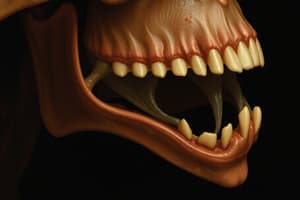Podcast
Questions and Answers
Which nerve is associated with the 1st (I) Mandibular arch?
Which nerve is associated with the 1st (I) Mandibular arch?
- Trigeminal nerve (correct)
- Vagus nerve
- Facial nerve
- Glossopharyngeal nerve
What blood vessel is related to the 2nd (II) Hyoid arch?
What blood vessel is related to the 2nd (II) Hyoid arch?
- 4th aortic arch
- 2nd aortic arch (correct)
- 3rd aortic arch
- 1st aortic arch
What type of muscle is associated with the 3rd (III) pharyngeal arch?
What type of muscle is associated with the 3rd (III) pharyngeal arch?
Stylopharyngeal muscle
The cartilage of the larynx is formed from the 4th (IV) pharyngeal arch.
The cartilage of the larynx is formed from the 4th (IV) pharyngeal arch.
The bones that form from the 1st (I) Mandibular arch include the ______.
The bones that form from the 1st (I) Mandibular arch include the ______.
Which structure is formed from Reichert's cartilage?
Which structure is formed from Reichert's cartilage?
Which cranial nerve is associated with the 4th (IV) pharyngeal arch?
Which cranial nerve is associated with the 4th (IV) pharyngeal arch?
Study Notes
Pharyngeal Arch Development
- Pharyngeal arches form during embryonic development
- They are responsible for the development of structures in the head and neck
- These structures include facial muscles, bones of the face and skull, cartilage and muscles of the larynx
1st Pharyngeal Arch (Mandibular Arch)
- Associated with the trigeminal nerve (cranial nerve V)
- Supplied by the first aortic arch blood vessel
- Muscles of mastication develop from this arch (temporalis, masseter, lateral and medial pterygoids)
- Merkel's Cartilage forms within this arch
- Eventually forms:
- Mandible
- Portion of the maxilla
- Zygomatic bones
- Squamous portion of the temporal bone
- Malleus and incus of the ear
2nd Pharyngeal Arch (Hyoid Arch)
- Associated with the facial nerve (cranial nerve VII)
- Supplied by the second aortic arch blood vessel
- Muscles of facial expression develop from this arch
- Reichert's Cartilage forms within this arch
- Eventually forms:
- Part of the hyoid bone
- Styloid process
- Stapes
3rd Pharyngeal Arch
- Associated with the glossopharyngeal nerve (cranial nerve IX)
- Supplied by the third aortic arch blood vessel
- Contains the stylopharyngeal muscle (helps with swallowing)
- No cartilage forms within this arch
- Eventually forms:
- Part of the hyoid bone
- Connective tissue of the thymus
- Inferior parathyroid
4th Pharyngeal Arch
- Associated with the superior laryngeal branch of the vagus nerve (cranial nerve X)
- Supplied by the fourth aortic arch blood vessel
- Gives rise to laryngeal muscles
- Forms cartilage of the larynx (thyroid, corniculate, and cuneiform cartilages)
Studying That Suits You
Use AI to generate personalized quizzes and flashcards to suit your learning preferences.
Description
Test your knowledge on the development of pharyngeal arches during embryonic development, their associated structures, and functions. This quiz covers the first two pharyngeal arches, including the cranial nerves involved, muscles formed, and bones developed. Challenge yourself to recall key details about these vital components of head and neck anatomy.




